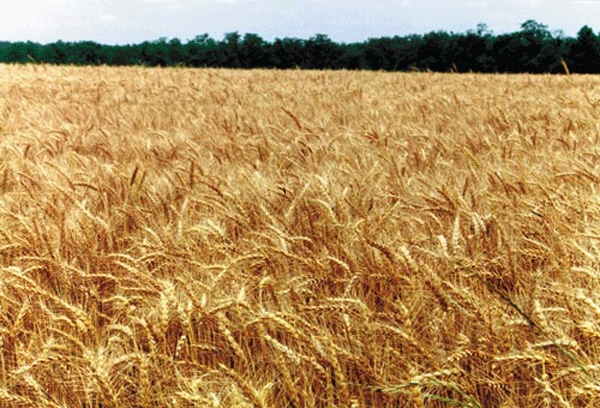
Soft red winter wheat growing in popularity
• From the farm to the elevator, SRW farmers in Ohio, Maryland, Virginia, Arkansas and several other states in the eastern United States have access to both domestic and international markets. • Ohio leads the region by producing 45.8 million bushels of SRW in 2010, according to USDA’s National Agricultural Statistics Service.• Maryland and Virginia produced 8.1 million bushels and 8.16 million bushels respectively.
March 8, 2011

Doug Goyings knows exactly where his wheat goes after leaving his farm. Goyings, who farms about 800 acres of soft red winter (SRW) wheat in addition to corn and soybeans in Paulding, Ohio, dropped his cell phone in a semi-load of wheat during harvest. To his surprise, he received a call from a facility in Georgia weeks later where his wheat was being cleaned.
From the farm to the elevator, SRW farmers like Goyings in Ohio, Maryland, Virginia, Arkansas and several other states in the eastern United States have access to both domestic and international markets.
Ohio leads the region by producing 45.8 million bushels of SRW in 2010, according to USDA’s National Agricultural Statistics Service. Maryland and Virginia produced 8.1 million bushels and 8.16 million bushels respectively. Goyings explained that in addition to planting wheat as part of a rotation with corn and soybeans, he takes advantage of regional needs to increase his income per acre of wheat. Goyings also bales wheat straw and sells it as bedding for Kentucky racehorses or as mulch to the nursery industry.
Robert Hutchinson, who grows SRW on the eastern shore of Maryland in Cordova, also plants SRW as a part of a rotation. He explained that he is far enough south to plant soybeans behind his wheat, but timing is critical. “With wheat, you have to get crops planted and harvested within a short window of time,” Hutchinson said. “It is twice the work to plant two crops, but you have twice the chance to hit a home run.”
Maryland faces additional challenges with rainfall and runoff into the Chesapeake Bay. Runoff into the Bay is strictly managed, and many wheat farmers have implemented management practices like no-till tillage, broadcast seeding using vertical-tillage and slow release fertilizer as part of an inter-industry effort to restore Bay waters to sustainably healthy levels.
As part of that effort, Hutchinson explained Maryland has a cover crop program that pays farmers to plant crops like wheat or barley. The crop can be harvested, but no fall fertilizer can be applied and no spring fertilizers can be applied before March 1, reducing the yield output of the crop.
Crop competition a challenge
An additional challenge east of the Mississippi River is crop competition — and not just with corn and soybeans. Hutchinson explained that barley is an increasing competitor to wheat on the eastern shore, but the market is not as steady as for wheat. “Wheat has a better bang for its buck,” he said.
John Hoffman, who farms about 400 to 500 acres of SRW with his father in Circleville, Ohio, agreed that the diversity of crops that can be grown in Ohio’s fertile soil can make planting decisions difficult. “You have to enjoy growing wheat, because it is hard to compete with corn and soybeans,” Hoffman said. Hoffman also double-crops soybeans behind his wheat. In addition to a short timeframe to harvest wheat and plant soybeans, he explained that high levels of humidity and rainfall can make disease management difficult.
However, Hoffman explained that advances in technology have helped make management easier and better for the environment. For example, global positioning satellite technology allows him to more accurately apply fertilizer and crop protection products where they are needed.
Wheat researchers in the eastern United States at Ohio State University, the University of Maryland and Virginia Polytechnic Institute and State University (Virginia Tech) are working to further improve wheat quality, disease resistance and yield for SRW.
In November 2010, Virginia Tech was the second public university to sign a public-private collaborative agreement with Monsanto to advance their wheat breeding programs and generate superior varieties. The agreement will initially focus on improving yield and increasing resistance to Fusarium head blight (scab).
From the shores of the Chesapeake Bay to the shores of Lake Erie, farmers east of the Mississippi River will continue to grow high quality SRW wheat ideal for both international and domestic customers.
Goyings said he expects there will always be wheat around, but that agriculture will continue to find ways to be more efficient. “If it wasn’t for the innovative farmer, we wouldn’t be growing what we do today,” Goyings said. “Innovation…that’s agriculture.”
EDITOR’S NOTE — The generous financial support from U.S. wheat producer check-off dollars managed by 19 state wheat commissions and cost-share funding provided by USDA’s Foreign Agricultural Service ensure that USW has the resources needed to help overseas buyers understand the reliability and functional benefits of U.S. milling wheat.
You May Also Like



